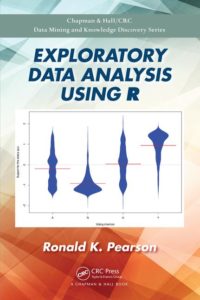Exploratory Data Analysis Using R
Author: Ronald K. Pearson
Textbook – 548 Pages – 11 Color & 132 B/W Illustrations
ISBN 9781498730235 – CAT# K26119
Series: Chapman & Hall/CRC Data Mining and Knowledge Discovery Series
For Instructors Request an e-inspection copy
Features
- Combines an introduction to R programming with an introduction to exploratory data analysis
- Targets students and working professionals with a limited technical background
- Focuses on data anomalies: what they are, why they arise, how they can invalidate an otherwise reasonable analysis, how to detect them, and what to do about them
- Includes a practical introduction to text mining
- Emphasizes R graphics – particularly novel graphics like beanplots – both for exploratory use by the analyst and for the explanation of results to others
Summary
Exploratory Data Analysis Using R provides a classroom-tested introduction to exploratory data analysis (EDA) and introduces the range of “interesting” – good, bad, and ugly – features that can be found in data, and why it is important to find them. It also introduces the mechanics of using R to explore and explain data.
The book begins with a detailed overview of data, exploratory analysis, and R, as well as graphics in R. It then explores working with external data, linear regression models, and crafting data stories. The second part of the book focuses on developing R programs, including good programming practices and examples, working with text data, and general predictive models. The book ends with a chapter on “keeping it all together” that includes managing the R installation, managing files, documenting, and an introduction to reproducible computing.
The book is designed for both advanced undergraduate, entry-level graduate students, and working professionals with little to no prior exposure to data analysis, modeling, statistics, or programming. it keeps the treatment relatively non-mathematical, even though data analysis is an inherently mathematical subject. Exercises are included at the end of most chapters, and an instructor’s solution manual is available.
About the Author:
Ronald K. Pearson holds the position of Senior Data Scientist with GeoVera, a property insurance company in Fairfield, California, and he has previously held similar positions in a variety of application areas, including software development, drug safety data analysis, and the analysis of industrial process data. He holds a PhD in Electrical Engineering and Computer Science from the Massachusetts Institute of Technology and has published conference and journal papers on topics ranging from nonlinear dynamic model structure selection to the problems of disguised missing data in predictive modeling. Dr. Pearson has authored or co-authored books including Exploring Data in Engineering, the Sciences, and Medicine (Oxford University Press, 2011) and Nonlinear Digital Filtering with Python. He is also the developer of the DataCamp course on base R graphics and is an author of the datarobot and GoodmanKruskal R packages available from CRAN (the Comprehensive R Archive Network).
